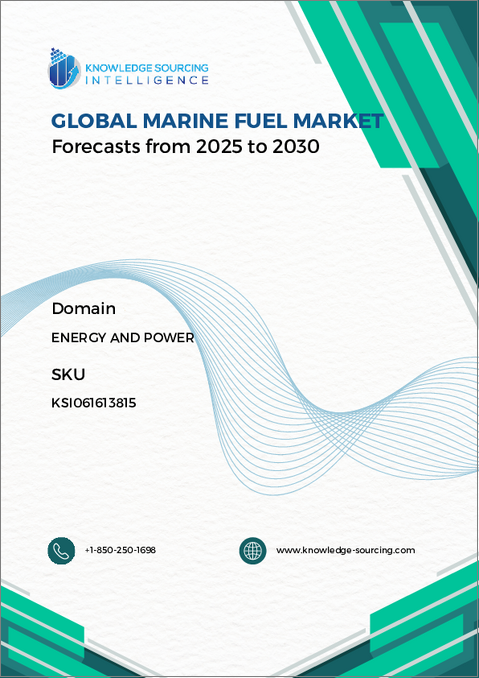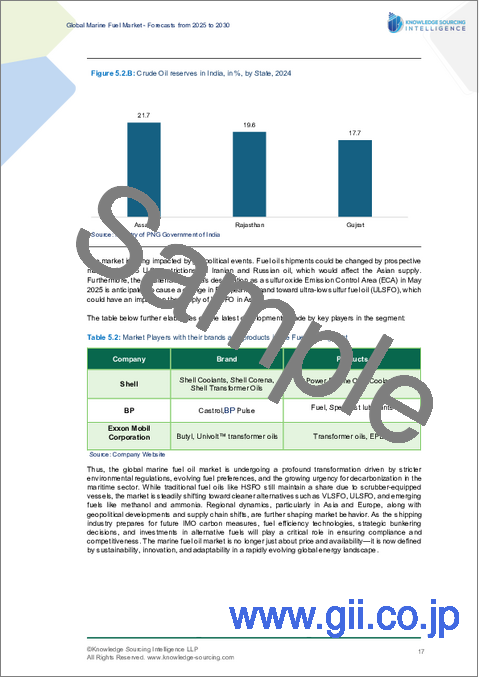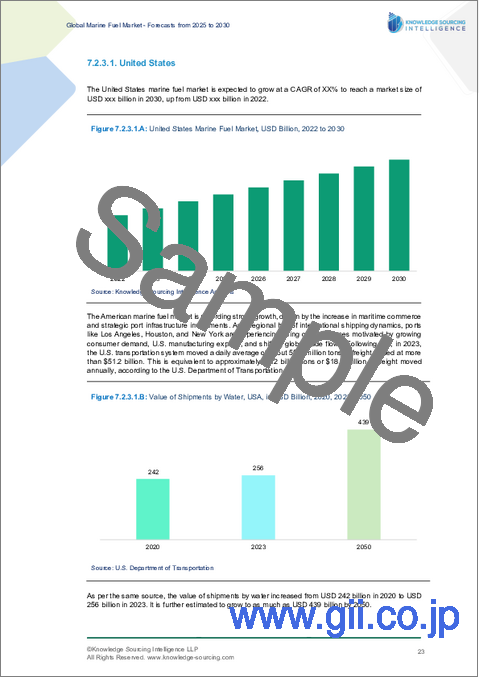|
|
市場調査レポート
商品コード
1697447
船舶用燃料の世界市場:将来予測 (2025年~2030年)Global Marine Fuel Market - Forecasts from 2025 to 2030 |
||||||
カスタマイズ可能
|
|||||||
| 船舶用燃料の世界市場:将来予測 (2025年~2030年) |
|
出版日: 2025年02月14日
発行: Knowledge Sourcing Intelligence
ページ情報: 英文 135 Pages
納期: 即日から翌営業日
|
全表示
- 概要
- 目次
船舶用燃料市場は、2025年の1,406億1,900万米ドルから2030年には1,714億9,400万米ドルまで、CAGR4.05%で成長すると予測されます。
海上貿易の拡大が市場拡大の原動力となると思われます。予測期間中、船舶用燃料市場は、持続可能性への注目の高まりにより大きな変化を目の当たりにすると思われます。海運業界における環境規制の高まりにより、低硫黄燃料やLNGといった燃料の需要が高まると思われます。バイオ燃料のような船舶用燃料生産技術などの技術進歩は、市場を従来の燃料から持続可能性を提供する革新的な燃料へと移行させると思われます。
市場動向:
- 船舶用燃料需要を牽引する世界の海上貿易量の増加:船舶用燃料市場は、主に世界の海上貿易量の急増によって支えられています。国際海運会議所によると、海運業は世界貿易の基幹産業であり、世界の物資輸送の約90%を担っています。こうした海運への依存度の高さが、船舶用燃料の需要を大きく押し上げています。
- 規制の変化と技術の進歩:船舶用燃料市場は、規制圧力の高まりにより大きな変革期を迎えており、政府基準に適合した効率的で持続可能な燃料への需要が高まっています。生産プロセスの進歩や、データ解析やセンサーなどの新技術の統合を含む船舶用燃料技術の革新が、市場成長の原動力となっています。さらに、バイオ燃料、水素、アンモニア、合成液化天然ガス、メタノール製造の開発が市場をさらに拡大しています。
- 北米の市場開拓:北米は船舶用燃料市場で大きなシェアを占めると予想されます。米国海洋産業は、米国政府NOAA事務局の報告書でも強調されているように、上昇基調にあります。
- 海上貿易におけるアジア太平洋地域の優位性:アジア太平洋地域は、海上貿易量の多さから、船舶用燃料市場で大きなシェアを占めています。中国、インド、韓国などの経済成長は、海上貿易をさらに促進しています。UNCTADの統計によると、アジアは2023年に世界最大の貿易地域となり、世界の港湾上位25港のうち10港がアジアに位置しています。
当レポートで取り上げられている主要企業には、Shell、BP、Exxon Mobil Corporation、Nesteなどがあります。
当レポートの主な利点
- 洞察に満ちた分析:顧客セグメント、政府政策と社会経済要因、消費者の嗜好、産業別、その他のサブセグメントに焦点を当て、主要地域だけでなく新興地域もカバーする詳細な市場考察を得ることができます。
- 競合情勢:世界の主要企業が採用している戦略的作戦を理解し、適切な戦略による市場浸透の可能性を理解することができます。
- 市場促進要因と将来動向:ダイナミックな要因と極めて重要な市場動向、そしてそれらが今後の市場展開をどのように形成していくかを探ります。
- 行動可能な提言:ダイナミックな環境の中で、新たなビジネスストリームと収益を発掘するための戦略的意思決定に洞察を活用します。
- 幅広い利用者に対応:新興企業、研究機関、コンサルタント、中小企業、大企業にとって有益で費用対効果が高いです。
どのような用途で利用されていますか?
業界・市場考察、事業機会評価、製品需要予測、市場参入戦略、地理的拡大、設備投資決定、規制の枠組みと影響、新製品開発、競合の影響
分析範囲
- 過去のデータ(2022~2024年)と予測データ (2025~2030年)
- 成長機会、課題、サプライチェーンの展望、規制枠組み、顧客行動、動向分析
- 競合企業のポジショニング・戦略・市場シェア分析
- 収益成長率と予測分析:セグメント別・地域別 (国別)
- 企業プロファイリング (戦略、製品、財務情報、主な動向など)
船舶用燃料市場は以下のセグメント別に分析されます:
種類別
- 燃料油
- 軽油(ガスオイル)
エンドユーザー別
- 石油タンカー
- ガスタンカー
- ケミカルタンカー
- 一般貨物船
- その他
地域別
- 北米
- 米国
- カナダ
- メキシコ
- 南米
- ブラジル
- アルゼンチン
- その他
- 欧州
- 英国
- ドイツ
- フランス
- スペイン
- その他
- 中東・アフリカ
- サウジアラビア
- UAE
- イスラエル
- その他
- アジア太平洋
- 日本
- 中国
- インド
- 韓国
- インドネシア
- タイ
- その他
目次
第1章 イントロダクション
- 市場概要
- 市場の定義
- 分析範囲
- 市場セグメンテーション
- 通貨
- 前提条件
- 基準年と予測年のタイムライン
- 利害関係者にとっての主なメリット
第2章 分析手法
- 分析デザイン
- 分析プロセス
第3章 エグゼクティブサマリー
- 主な分析結果
- アナリストビュー
第4章 市場力学
- 市場促進要因
- 市場抑制要因
- ポーターのファイブフォース分析
- 業界バリューチェーン分析
第5章 世界の船舶用燃料市場:種類別
- イントロダクション
- 燃料油
- 軽油
第6章 世界の船舶用燃料市場:エンドユーザー別
- イントロダクション
- 石油タンカー
- ガスタンカー
- ケミカルタンカー
- 一般貨物船
- その他
第7章 世界の船舶用燃料市場:地域別
- イントロダクション
- 北米
- 種類別
- エンドユーザー別
- 国別
- 南米
- 種類別
- エンドユーザー別
- 国別
- 欧州
- 種類別
- エンドユーザー別
- 国別
- 中東・アフリカ
- 種類別
- エンドユーザー別
- 国別
- アジア太平洋
- 種類別
- エンドユーザー別
- 国別
第8章 競合環境と分析
- 主要企業と戦略分析
- 市場シェア分析
- 企業合併・買収 (M&A)、合意、事業協力
- 競合ダッシュボード
第9章 企業プロファイル
- Shell
- Neste
- BP
- Chevron Corporation
- Exxon Mobil Corporation
- Mabanaft GmbH & Co. KG
- Uniper SE
- Global Partners LP
- Lukoil
The Global Marine Fuel Market is expected to grow at a compound annual growth rate (CAGR) of 4.05% from US$140.619 billion in 2025 to US$171.494 billion in 2030.
The growing maritime trade will be driving the market expansion. In the forecast period, the marine fuel market will witness significant changes due to increasing focus on sustainability. The demand for fuels such as low-sulfur fuels and LNG will rise owing to the growing environmental regulations in the maritime trade industry. Technological advancements such as marine fuel production technology like biofuels will transition the market from traditional fuel to innovative fuels offering sustainability.
Market Trends:
- Rising global seaborne trade driving marine fuel demand: The marine fuel market is primarily fueled by the booming volume of global seaborne trade. According to the International Chamber of Shipping, the shipping industry is the backbone of global trade, handling approximately 90% of the world's goods transportation. This heavy reliance on shipping is significantly boosting the demand for marine fuel.
- Regulatory shifts and technological advancements: The marine fuel market is undergoing a major transformation due to increasing regulatory pressures, leading to a growing demand for efficient and sustainable fuels that comply with government standards. Innovations in marine fuel technology, including advancements in production processes and the integration of emerging technologies like data analytics and sensors, are driving market growth. Additionally, developments in biofuel, hydrogen, ammonia, synthetic liquefied natural gas, and methanol production are further expanding the market.
- North America's market growth: North America is expected to hold a substantial share of the global marine fuel market. The U.S. marine industry is on an upward trajectory, as highlighted in a report by the NOAA office of the U.S. government. Increasing regulatory compliance, driven by environmental concerns and a focus on sustainability, is propelling the market's expansion.
- Asia-Pacific's dominance in maritime trade: The Asia-Pacific region commands a significant share of the marine fuel market, largely due to its high maritime trade volume. The growing economies of countries like China, India, and South Korea are further boosting maritime trade. According to UNCTAD statistics, Asia was the world's largest trading region in 2023, with 10 of the top 25 global ports located in the region, underscoring Asia's resilience and dominance in maritime trade.
Some of the major players covered in this report include Shell, BP, Exxon Mobil Corporation, Neste, among others.
Key Benefits of this Report:
- Insightful Analysis: Gain detailed market insights covering major as well as emerging geographical regions, focusing on customer segments, government policies and socio-economic factors, consumer preferences, industry verticals, and other sub-segments.
- Competitive Landscape: Understand the strategic maneuvers employed by key players globally to understand possible market penetration with the correct strategy.
- Market Drivers & Future Trends: Explore the dynamic factors and pivotal market trends and how they will shape future market developments.
- Actionable Recommendations: Utilize the insights to exercise strategic decisions to uncover new business streams and revenues in a dynamic environment.
- Caters to a Wide Audience: Beneficial and cost-effective for startups, research institutions, consultants, SMEs, and large enterprises.
What do businesses use our reports for?
Industry and Market Insights, Opportunity Assessment, Product Demand Forecasting, Market Entry Strategy, Geographical Expansion, Capital Investment Decisions, Regulatory Framework & Implications, New Product Development, Competitive Intelligence
Report Coverage:
- Historical data from 2022 to 2024 & forecast data from 2025 to 2030
- Growth Opportunities, Challenges, Supply Chain Outlook, Regulatory Framework, and Trend Analysis
- Competitive Positioning, Strategies, and Market Share Analysis
- Revenue Growth and Forecast Assessment of segments and regions including countries
- Company Profiling (Strategies, Products, Financial Information, and Key Developments among others)
Global Marine Fuel Market is analyzed into the following segments:
By Type
- Fuel Oil
- Gas Oil
By End-User
- Oil Tanker
- Gas Tanker
- Chemical Tanker
- General Cargo
- Others
By Geography
- North America
- § United States
- § Canada
- § Mexico
- South America
- § Brazil
- § Argentina
- § Others
- Europe
- § United Kingdom
- § Germany
- § France
- § Spain
- § Others
- Middle East and Africa
- § Saudi Arabia
- § UAE
- § Israel
- § Others
- Asia Pacific
- § Japan
- § China
- § India
- § South Korea
- § Indonesia
- § Thailand
- § Others
TABLE OF CONTENTS
1. INTRODUCTION
- 1.1. Market Overview
- 1.2. Market Definition
- 1.3. Scope of the Study
- 1.4. Market Segmentation
- 1.5. Currency
- 1.6. Assumptions
- 1.7. Base and Forecast Years Timeline
- 1.8. Key Benefits for the Stakeholders
2. RESEARCH METHODOLOGY
- 2.1. Research Design
- 2.2. Research Process
3. EXECUTIVE SUMMARY
- 3.1. Key Findings
- 3.2. Analyst View
4. MARKET DYNAMICS
- 4.1. Market Drivers
- 4.2. Market Restraints
- 4.3. Porter's Five Forces Analysis
- 4.3.1. Bargaining Power of Suppliers
- 4.3.2. Bargaining Power of Buyers
- 4.3.3. Threat of New Entrants
- 4.3.4. Threat of Substitutes
- 4.3.5. Competitive Rivalry in the Industry
- 4.4. Industry Value Chain Analysis
5. GLOBAL MARINE FUEL MARKET BY TYPE
- 5.1. Introduction
- 5.2. Fuel Oil
- 5.3. Gas Oil
6. GLOBAL MARINE FUEL MARKET BY END-USER
- 6.1. Introduction
- 6.2. Oil Tanker
- 6.3. Gas Tanker
- 6.4. Chemical Tanker
- 6.5. General Cargo
- 6.6. Others
7. GLOBAL MARINE FUEL MARKET BY GEOGRAPHY
- 7.1. Introduction
- 7.2. North America
- 7.2.1. By Type
- 7.2.2. By End-User
- 7.2.3. By Country
- 7.2.3.1. USA
- 7.2.3.2. Canada
- 7.2.3.3. Mexico
- 7.3. South America
- 7.3.1. By Type
- 7.3.2. By End-User
- 7.3.3. By Country
- 7.3.3.1. Brazil
- 7.3.3.2. Argentina
- 7.3.3.3. Others
- 7.4. Europe
- 7.4.1. By Type
- 7.4.2. By End-User
- 7.4.3. By Country
- 7.4.3.1. United Kingdom
- 7.4.3.2. Germany
- 7.4.3.3. France
- 7.4.3.4. Spain
- 7.4.3.5. Others
- 7.5. Middle East and Africa
- 7.5.1. By Type
- 7.5.2. By End-User
- 7.5.3. By Country
- 7.5.3.1. Saudi Arabia
- 7.5.3.2. UAE
- 7.5.3.3. Others
- 7.6. Asia Pacific
- 7.6.1. By Type
- 7.6.2. By End-User
- 7.6.3. By Country
- 7.6.3.1. China
- 7.6.3.2. Japan
- 7.6.3.3. South Korea
- 7.6.3.4. Australia
- 7.6.3.5. India
- 7.6.3.6. Indonesia
- 7.6.3.7. Thailand
- 7.6.3.8. Others
8. COMPETITIVE ENVIRONMENT AND ANALYSIS
- 8.1. Major Players and Strategy Analysis
- 8.2. Market Share Analysis
- 8.3. Mergers, Acquisitions, Agreements, and Collaborations
- 8.4. Competitive Dashboard
9. COMPANY PROFILES
- 9.1. Shell
- 9.2. Neste
- 9.3. BP
- 9.4. Chevron Corporation
- 9.5. Exxon Mobil Corporation
- 9.6. Mabanaft GmbH & Co. KG
- 9.7. Uniper SE
- 9.8. Global Partners LP
- 9.9. Lukoil





